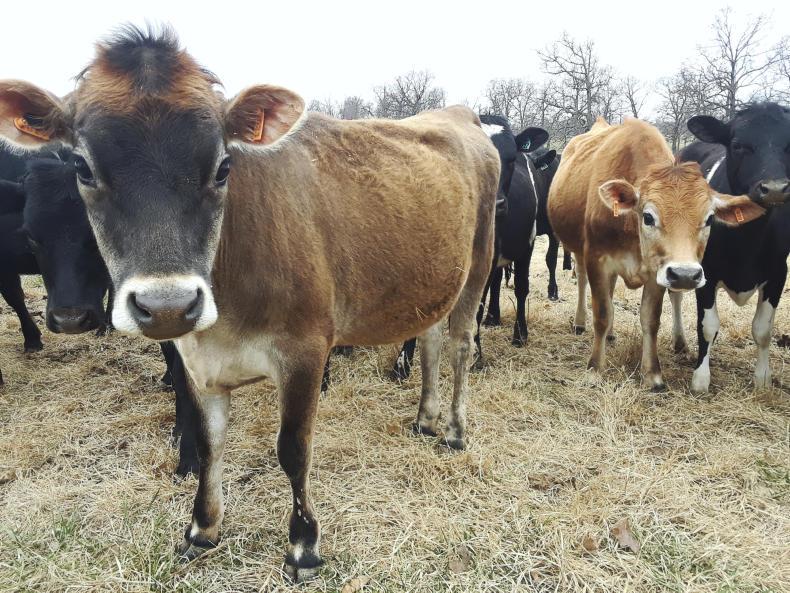My first experience of dairy farming in America was a long way from what you may see on a fancy magazine or a newspaper.
Based out of Miller, Missouri, I landed on to one of the many grassland-owned farms in America. My experience began in early January just before calving was due to commence.
The farm has 550 Jersey-cross cows on 250ha of grass. The farm has another 200ha used to grow maize and winter rye. Cows remain outdoors all year and keeping profits up and costs down was the farm’s main aim.
Calving
Calving was a very busy period and having all hands on deck was paramount to the farm working efficiently. The farm had a manager, a full-time employee and two interns - fellow student Eoin McGrath and myself.
The herd was synchronised and AI was used. As a result of synchronisation, half the herd calves within two weeks beginning at the end of January.
Cows are kept on winter rye and calve down here. Conditions are far from ideal, but cows have adapted over the years and can manage through cold spells (-15°C) and scorching temperatures in the summer (35°C).
I worked seven nights in a row during the busy period, doing 12-hour shifts. During the night, temperatures would plummet to lows of -10°C.
At this temperature, calves would die within half an hour of being born if not tended to. At peak times, there would be up to 25 calves a day, so constant supervision of the herd was key to keeping deaths to a minimum.
Grass
The farm had a motto of ‘you look after the grass, the grass looks after the cows and the cows will look after the finances’.
Grass was absolutely crucial to this outdoor system working properly; if the grass was not being managed effectively you could find yourself in a difficult situation.
Cows left the winter rye in mid-February and once they started lactating they were put on grass.
Grass walks were completed every week and each cow’s intake was measured down to the kilo. When making grass breaks, we used GPS to measure the area for every cow, as every metre counted. Hitting the residual was not just an aim but a must.
Breaking down the numbers, milk sells for $0.37/l, with average butterfat at 4.2% and protein at 3.5%. Milk prices in America vary greatly from state to state.
At the end of March, cows were fed 4kg of concentrates per day and were allocated 13kg/DM of grass. The cows produce an average of 26kg of milk per day during the month of March and milk yield peaks in May.
Costs
The farm is run on minimum costs. It was always about keeping expenses down and they believed low costs and low input would lead to bigger profits and better returns.
Cows are kept outdoors all year for the simple reason that it is cheaper to have cows outdoors eating grass than indoors eating silage. The farm has one shed for calves, a tractor barn, and a milking parlour.
The parlour was a very basic 40-unit herringbone with no ACR or automatic washing and there was one tractor, a cabless John Deere 6115M.
Cow health was another factor that was of great importance. Due to the tough conditions that the cows had to endure, making cow health a priority was imperative.
Milk fever was a big problem on the farm as a result of high potassium levels in the soil. Other issues include bloat, lameness and grass tetany.
Mastitis was also in no short supply. Both clinical and sub-clinical mastitis was a big problem.
Somatic cell counts often exceeded the preferred threshold levels. When this happened we would carry out the California mastitis test on the entire herd and treat all mastitis cases with antibiotics.
As the locals say, farming in Missouri is far from glamorous farming. I remember one morning, Eoin and I were milking when we had to get a bucket of boiling water to dip our hands in to prevent them from going completely numb, as the temperatures had dropped to -15°C.
Learnings
Working on a dairy farm like this was an eye opener. I gained invaluable experience, exposed myself to all aspects of animal health and the treatment of cows, improved my knowledge in grass management and learned that managing grass properly is the difference between a successful and unsuccessful dairy farm.
Despite this time of economic uncertainty and natural disasters, I do believe that travelling overseas to other farms and experiencing their operations will lead to new ideas, new skills and new opportunities to employ on your home farm.
It also makes me more grateful for the modern infrastructure and progressive farming that we have in Ireland. I might not even complain about the rain.






 This is a subscriber-only article
This is a subscriber-only article










SHARING OPTIONS: